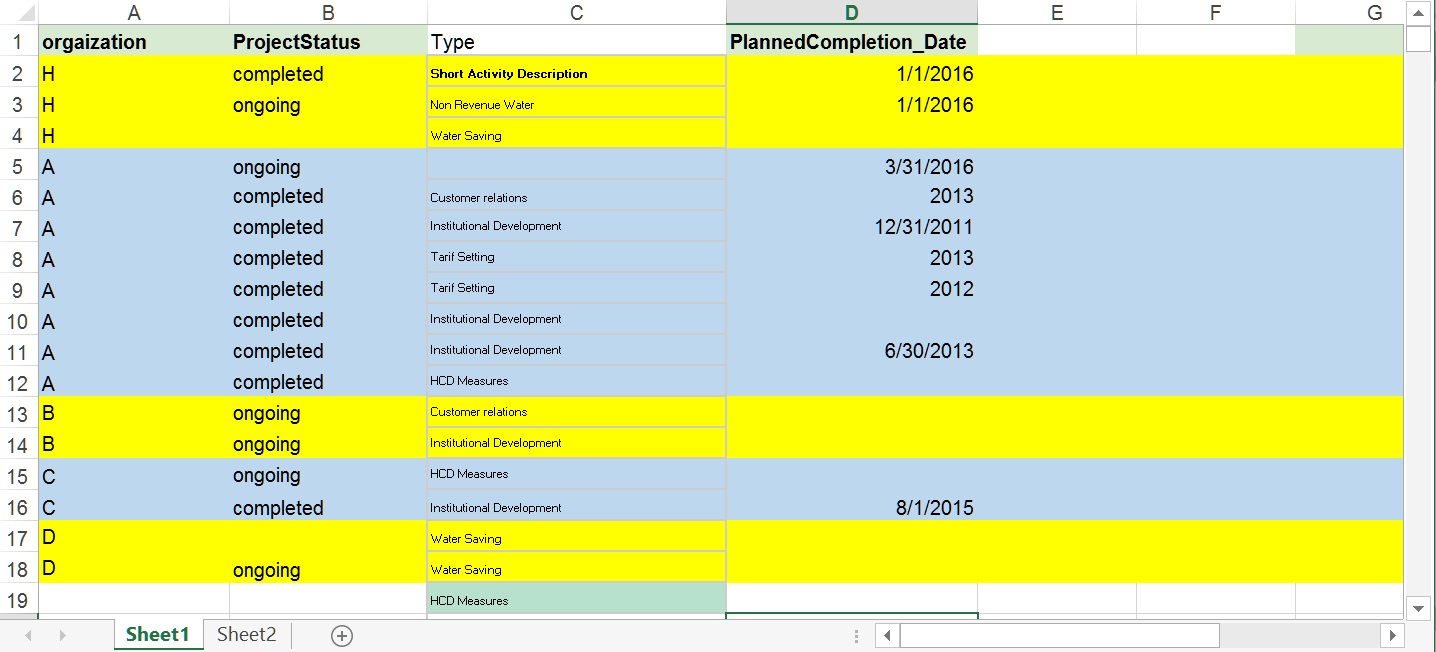- Home
- :
- All Communities
- :
- Products
- :
- Data Management
- :
- Data Management Questions
- :
- Re: What is the best practice to map one to many r...
- Subscribe to RSS Feed
- Mark Topic as New
- Mark Topic as Read
- Float this Topic for Current User
- Bookmark
- Subscribe
- Mute
- Printer Friendly Page
What is the best practice to map one to many relationship?
- Mark as New
- Bookmark
- Subscribe
- Mute
- Subscribe to RSS Feed
- Permalink
- Report Inappropriate Content
I need to show all of the activates in a certain area, I have the following data

But the problem is the the A organization has 8 projects, and for H on 3 projects as shown, and so on.
The implemented projects sometimes varies in location and this is easy to map but sometimes they are in the same location such as ( capacity buildings, Institutional Development, Customer relations,….)
I am now confused if I should create one point for the “A” organization for example and then link it to a table of the projects because this is the right behavior in creating the database, but the now I care more about viewing data on a PDF map. So what can be done here to show that data in an effective method and managing the database correctly.
Solved! Go to Solution.
Accepted Solutions
- Mark as New
- Bookmark
- Subscribe
- Mute
- Subscribe to RSS Feed
- Permalink
- Report Inappropriate Content
Make query Table is a convenient way of setting up a one to many relationship.
- Mark as New
- Bookmark
- Subscribe
- Mute
- Subscribe to RSS Feed
- Permalink
- Report Inappropriate Content
sounds convoluted, but they do have some guidance i have stumbled across relating to the temporal component and how to manage it Temporal data in separate tables—Help | ArcGIS for Desktop
- Mark as New
- Bookmark
- Subscribe
- Mute
- Subscribe to RSS Feed
- Permalink
- Report Inappropriate Content
Dear Dan,
Many thanks for the input, but the here ( between the table and the feature class) will not do the job, since the joint will include one value from the table to the feature class, What about other values that have the same ID and should be connected to the same point ?!
The organization A is represented as one point on the map but in the stand-alone table there is 4 records the related to A by the ID and here the join will only include join one recored form the table and ignore the others.
Thanks
- Mark as New
- Bookmark
- Subscribe
- Mute
- Subscribe to RSS Feed
- Permalink
- Report Inappropriate Content
Make query Table is a convenient way of setting up a one to many relationship.
- Mark as New
- Bookmark
- Subscribe
- Mute
- Subscribe to RSS Feed
- Permalink
- Report Inappropriate Content
Thanks mike,
it seem that Make query table is the best solution till now, but it generates new layer that have points over each other. for example if the Organization A has 10 projects in the table it will generates 10 overlaying points in the new layer, how can I move them (offset) the points to be shown on the map as 10 clustered points.
- Mark as New
- Bookmark
- Subscribe
- Mute
- Subscribe to RSS Feed
- Permalink
- Report Inappropriate Content
perhaps disperse markers or this older one
- Mark as New
- Bookmark
- Subscribe
- Mute
- Subscribe to RSS Feed
- Permalink
- Report Inappropriate Content
Many thanks Dan, Disperse makers did the job successfully
- Mark as New
- Bookmark
- Subscribe
- Mute
- Subscribe to RSS Feed
- Permalink
- Report Inappropriate Content
You might like to go for a relate, or even better, a relationship class. Check the following links for better understanding.
Deciding between relationship classes, relates, and joins
Benefits of Relationship Classes
Think Location
- Mark as New
- Bookmark
- Subscribe
- Mute
- Subscribe to RSS Feed
- Permalink
- Report Inappropriate Content
Hi,
This is for documentation since many users are looking forward showing one to many relations on a map. In my case the solution was based on Mike Cusi answer which suggests to use Make query Table. Then the second step is to move the overlapping points using disperse markers which suggested by Dan Patterson.
Many thanks guys for the help.